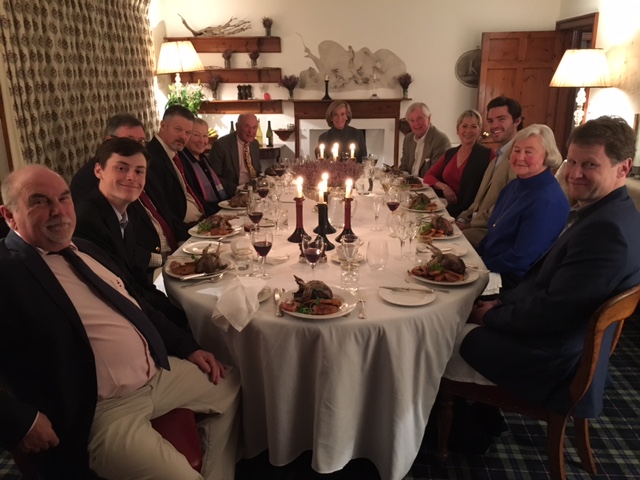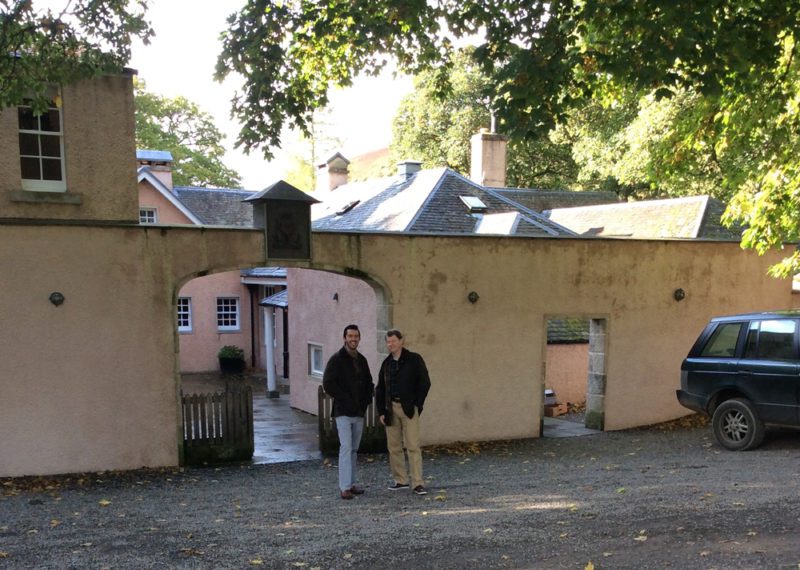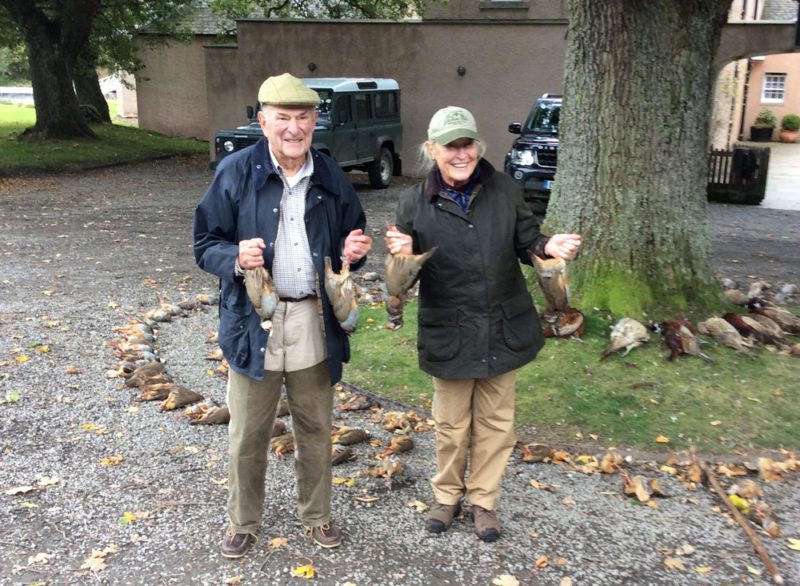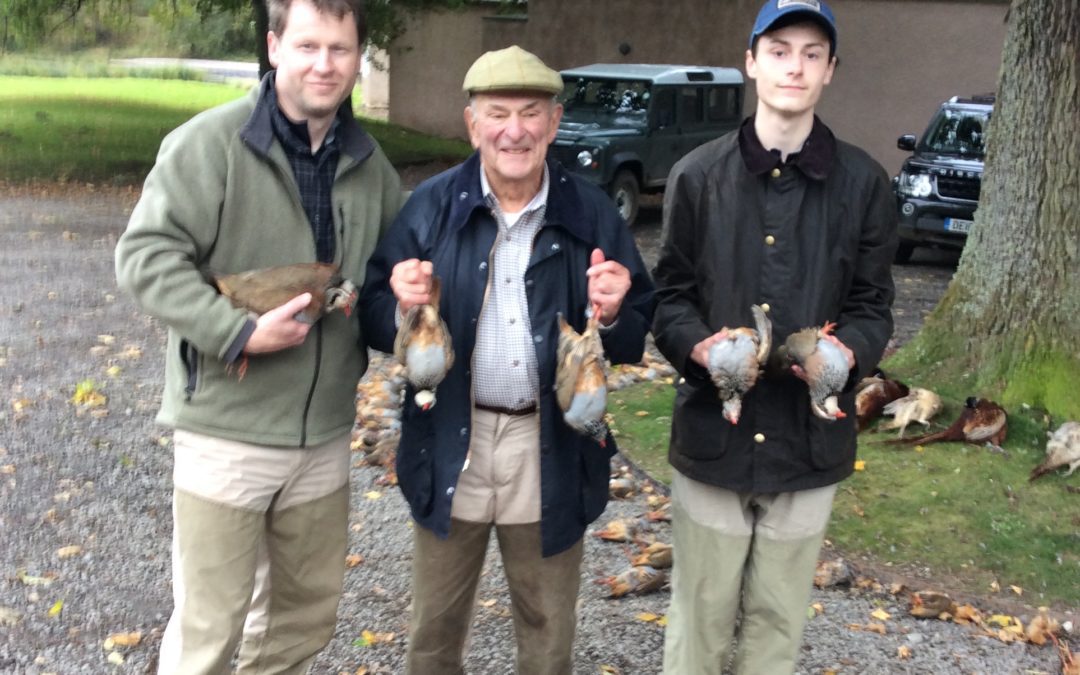Cover image, from left: David, Jim, and Aidan with their red partridge.
That evening we dined on red grouse—mild, dark meat prepared superbly. Bill began the toasts. We drank to the red grouse, the ruffed grouse, sharptails, huns, and redlegs; then to our hosts, the dogs, the gamekeepers, Vernon, some of our shots. It was a very wet and celebratory meal. The cook got a standing ovation.
Redlegs? We had two days of driven redleg shooting, the aforementioned banquet at the end of the first. Redlegs, or Spanish partridge, to my eyes look a lot like our Western chukar.
That morning at breakfast (and, indeed, the evening before over cocktails) Vernon had described driven Spanish partridge hunting to us: fast incomers flying over pine trees; shooting pegs positioned at the foot of hills with tall trees to force the birds higher, or at the bottom of gullies also with tall trees; the incoming birds 35 yards up or higher. These birds, unlike red grouse, liked altitude and sometimes climbed for protection. And they flew as fast as red grouse: long, fast shots, incoming at all angles. We could turn and, under the blue-sky rule (only shoot at birds surrounded by blue sky), take them to the side or going away.
Vernon emphasized the blue-sky rule—it was the most important element protecting the beaters, loaders, and our fellow shooters. No sticks to stop your swing and protect your fellows, only your good sense and judgment. Your loader was also your spotter and would call front, left, right, or too low, but your finger was on the trigger.

It was a very wet and celebratory meal. The cook got a standing ovation.
After breakfast I met my stuffer; to my delight, it was Gordon again, and he had brought his cocker spaniel. We assembled my Browning 12 gauge, and I screwed in improved cylinder and improved modified chokes. After the first two drives I changed the IC to full choke and shot IM/full – those birds were high! Gordon made certain that I had a sufficient amount of shells, then we left the gunroom for the four-wheel drives.
I drew peg number five. The river was 20 yards behind me, a pine-crested ridge 35 in front. Amos was at peg four and Tripp at six. Gordon loaded my shotgun and handed it to me. We were ready.
“They’ll be coming over the pines on the ridge in front of us. I’ll spot and load. Remember the blue-sky rule.
“We are live now. Birds may come anytime. Oh, there are some pheasant out there, also. They are fair game.”
That Vernon! He forgot to mention the pheasant. High, driven pheasant, that’d be nice.
“The pheasant usually fly at the end of the drive. They run ahead of the beaters until they have to fly—redlegs on the left, sir.”
Bang! Bang! I watch Tripp turn one bird into a puff of feathers and miss the second.
“Nice shot,” I yelled. But then the action starts and I need to pay attention.
“In front, sir.”
I look up and out and see four speeding birds coming directly at me—blue sky all around them. As I look my gun comes up and I swing butt, belly, beak, and an extra beat, arching my back and touching off my first shot of the day, A cloud of feathers in the air as I watch the bird come down behind me.
“Nice shot, sir,” as Gordon stuffs the gun, then, “Small group on the right.”

Tripp, left, and David in front of the lodge.
Small group, right! There are ten birds flying at various angles between Amos and me. Both of us have shots, and we both shoot. More feathers in the air, and I hear a thud as one of Amos’s birds lands just to my right. My bird is still falling—I got him with the full choke. Those birds are up there. Didn’t have a chance to fire the second—those birds are also fast.
“You may turn for a second shot, sir,” Gordon admonishes me gently.
Turn? Holy cow! Oh yeah, I can turn. That’s what loaders are also for—advisors. The next bird comes in fast; I turn, taking him going away and dropping him into the river. A big splash behind me as a Lab goes to work. Eject, reload, get ready. Try to stay calm. Right. Ahead! Shoot ahead. Lead, and if you miss with first barrel, double the lead and fire again. I take a lot of birds with the second barrel. I keep underestimating my lead for the first barrel.
“On the left, sir.” Five birds between Tripp and me. Tripp was busy reloading, so they were all mine. Hard swing, lead, bang, lead again, bang. One drops in the brush along the shore, the other in the river. My first double of the trip.
“A good pair, sir. Now get ready on the left.”
Bang, bang. Clean misses. So much for ego. Eject, stuff, look up and out. Wow! There are 50 birds in front, heading directly for Amos, Tripp, and me. We shoot, reload, shoot again, and repeat. The birds keep coming. Feathers in the air, thuds on the ground, birds folding, pinwheeling, and gliding.

Jim and Anne with redlegs. Note the pheasants near tree.
Then a pheasant—in front of me. Blue sky. Ahead and shoot; double it and shoot again. I watch my first driven pheasant plummet to the ground. Gordon has been spotting and loading. The barrels are hot even through my gloves. More birds on the left! I shoot, a very high shot, and break a wing; then the horn and I break the gun and hand it to Gordon. I am surrounded by 72 spent shells.
“Fast shooting, sir. A very good peg.”
I turn and watch the Labs work the river, the cocker spaniels working the far shore and a pair of springers the near. In front of me, more cockers and a Lab work the brush and bushes. A pleasure to watch these very experienced dogs at work.
Four more drives today, and I cannot wait!
A toast: to the men, the dogs, the birds, and the guns. To Scotland!

